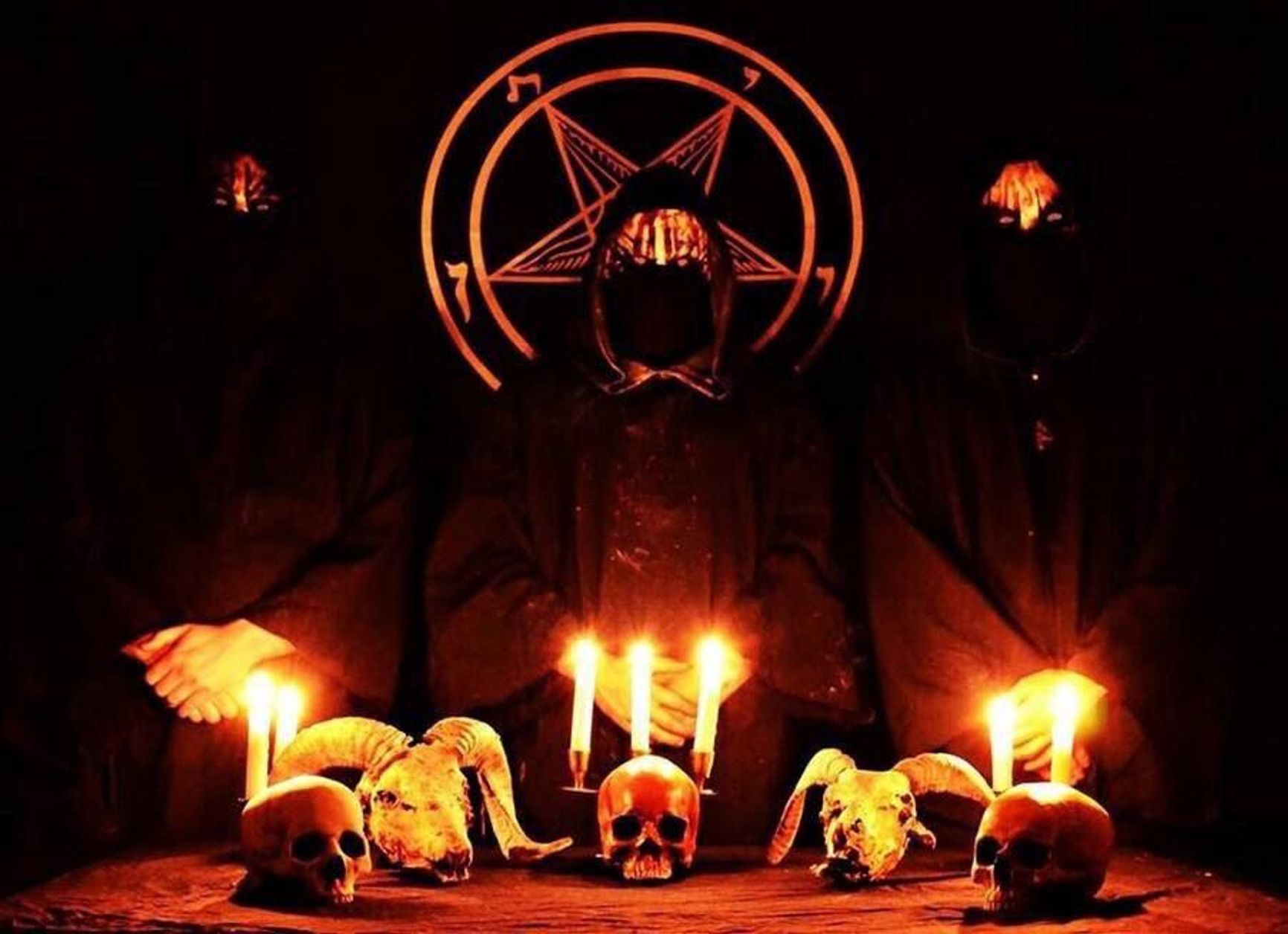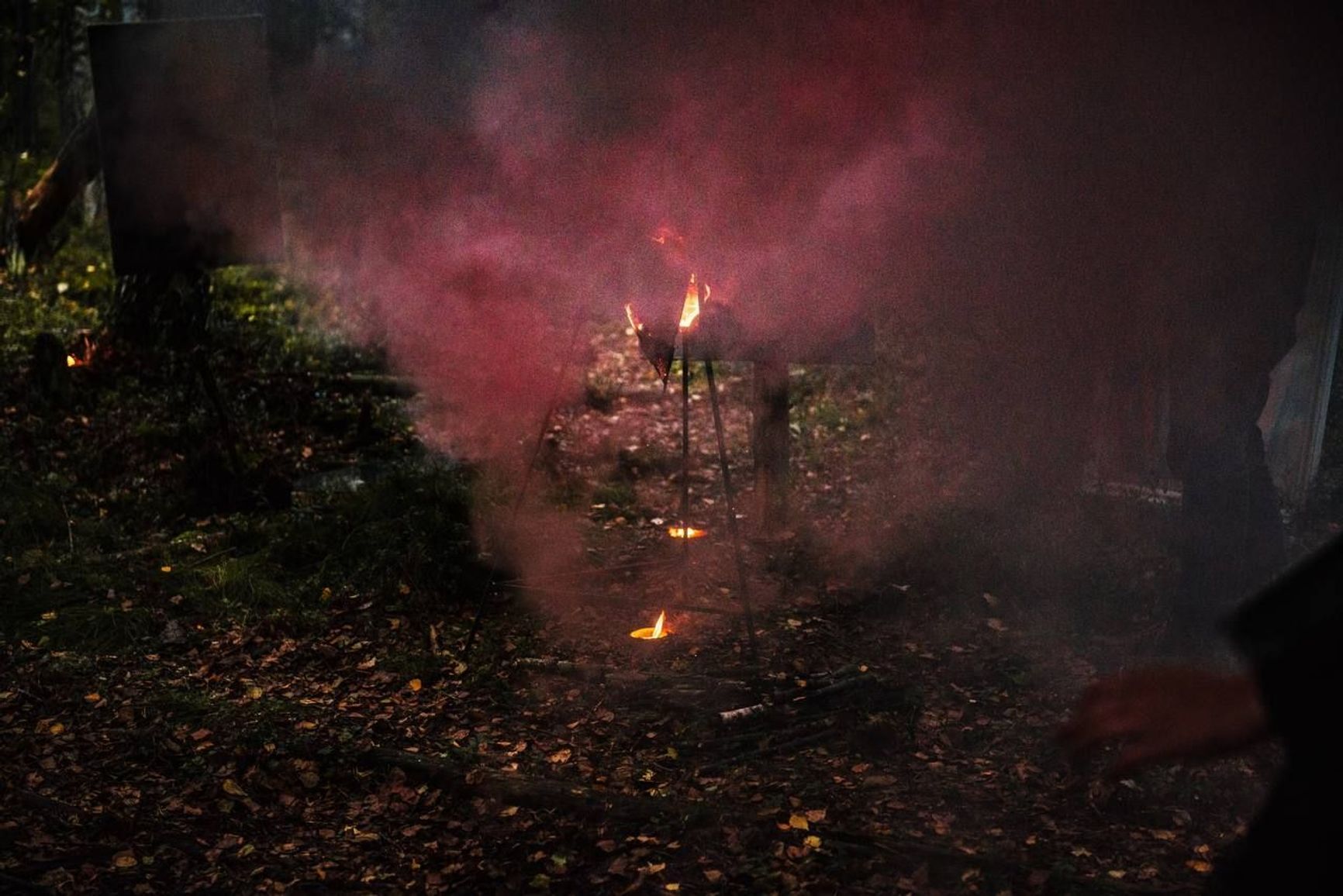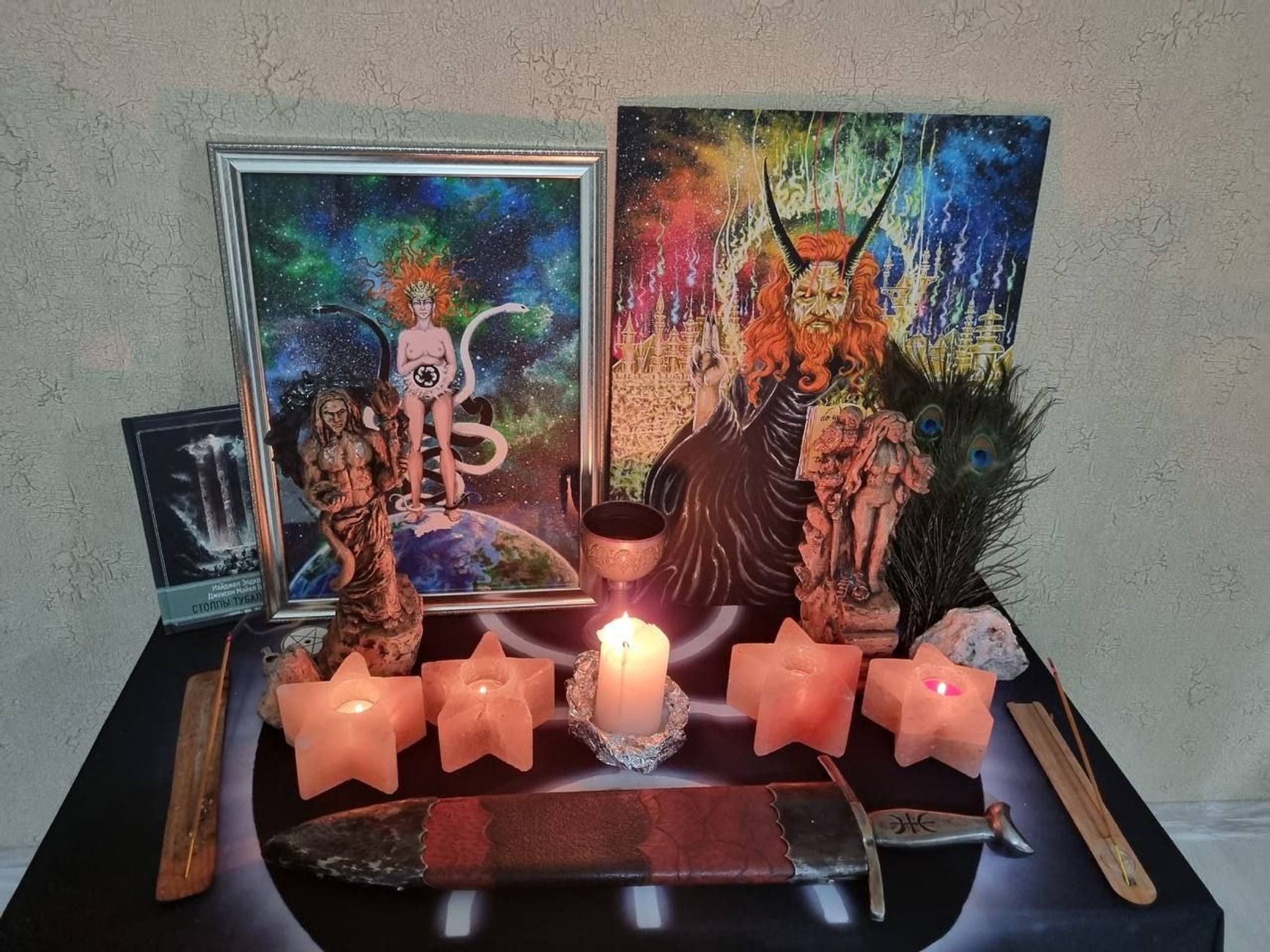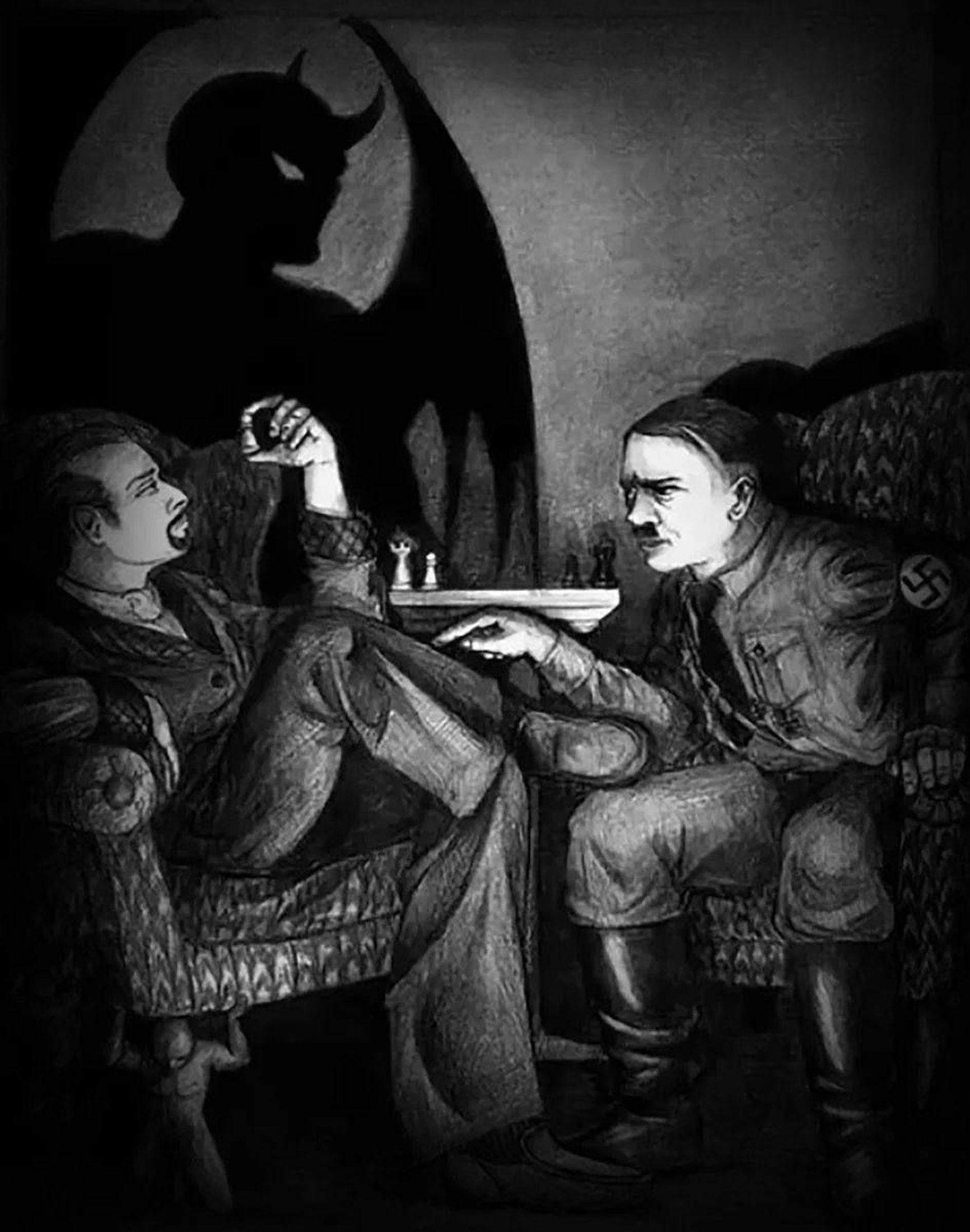

Shortly before launching the full-scale invasion of Ukraine in February 2022, Putin claimed that “the hegemony of the West is aimed at a complete denial of faith, acquiring features of Satanism.” Kremlin-backed propaganda immediately picked up on this new moniker for Europeans, adding it to old tropes about “Nazis” and “sodomites.” In reality, however, Satanism is a subculture that is thriving in Russia at this very minute. Moreover, “politically correct” Satanists – that is, those willing to take up arms and kill Ukrainians – are decorated with Russian government awards. The Insider took a closer look at how the flock of Lucifer is faring in today's Russia.
Content
A “holy” war
The essence and varieties of Satanism
Yes to beauty, no to Christianity
Marital sex as a dark ritual
“We don't like Hitler”
Satanists and Nazism
Who are Satanists for the Russian media?
A “holy” war
In September 2022, at the ceremony “accepting” the Russian-occupied Ukrainian territories of Kherson, Zaporizhzhia, Donetsk, and Luhansk into Russia, Vladimir Putin once again spoke about the West, demonizing it in the literal sense: “Such a complete denial of man, the subversion of faith and traditional values, and the suppression of freedom takes on the characteristics of religion in reverse – outright Satanism.” Aping Putin, Kremlin propagandists picked up the term.
In one of many examples, the often-cited talk show host Vladimir Solovyov asserted that the authorities in Ukraine, the U.S., and Western Europe serve the “prince of darkness” and equated negotiating with Ukraine to “bargaining with Satan.” As part of an extended rant, Solovyov, who until recently vacationed every summer at his villa on Lake Como in Italy, reasoned that, “In fact, if you think about it, what we see is Satanism. Demons, that's the only way to put it. ... If we are dealing with the cronies of the prince of darkness, if we are dealing with a satanic entity, what kind of negotiations are we even talking about? How can you bargain with Satan? They kept lying all the time. It is the basis of Western satanic civilization.” Solovyov said. He went on to compare a potential nuclear strike against the West to the destruction of Sodom and Gomorrah in the Old Testament.
Meanwhile, plagued with personnel shortages, the Russian military command is releasing murderers, cannibals, and serial rapists from prisons, promising them pardons in exchange for taking up arms. Some of them are real life Satanists, convicted of ritual murder. The Kremlin insists that these felons “atone for their guilt with blood” at the front.
On November 21, 2023, Nikolai Ogolobyak, 33, returned from the battlefield in Ukraine to his hometown of Yaroslavl, where he’d been serving a sentence for ritual murders.In 2008, Ogolobyak and his associates brutally murdered four people in a Satanic ritual before dismembering and eating the corpses. A court found them guilty in 2010. Ogolobyak received the maximum sentence of 20 years, of which he served 15 (including two years in pre-trial detention). He then filed a motion to participate in Russia's “special military operation.” After a short period of fighting, he was wounded and pardoned. Ogolobyak himself insisted in an interview that he “never ate anyone” and that the ritual murders “happened by accident.”

Nikolay Ogolobyak
But while satanists like Ogolobyak have been praised by the Kremlin’s propagandists, the mercenary group that sent them off to war, the Wagner private military company, has suffered a very different fate. In the first months of the war, Wagner fighters were hailed in pro-Kremlin media as heroes, with some “patriotic” mouthpieces going so far as to call them “saints,” “heavenly,” and “God's army.” However, after the late Wagner leader Yevgeny Prigozhin led an abortive armed rebellion against the Russian military command this past June, the Russian Orthodox clergy suddenly discovered that several of the mercenaries had gravitated towards paganism and Satanism.
In other words, any opponent of the current regime becomes a “Satanist” in the language of propaganda. Meanwhile, actual Satanism is a fairly popular subculture in Russia, with thousands of followers and a century-long history.
The essence and varieties of Satanism
The first Satanist communities emerged in the Russian Empire in the early 20th century, and it was not in Kharkiv or Odesa but in Saint Petersburg. As researchers Konstantin Kislyuk and Oleg Kucher write in “Religious Studies,” the Russian Satanist George Gurdjieff, who was nicknamed the Prophet of Beelzebub, enjoyed the personal patronage of Nicholas II. In the Soviet Union, the earliest Satanist groups appeared in the early 1970s in Moscow, Leningrad, and Odesa.

A few years ago, the Institute of Religion and Law counted about 300,000 followers of all non-traditional religions in Russia. It is difficult to determine the share of Satanists in the count, because many of them hide their worldview. It is even harder considering that Satanism is not a single religion but rather an eclectic collection of cults, beliefs, and philosophical systems. As scholar of religion Roman Krylov describes the dynamic, “Satanist groups are heterogeneous; there are also many loners whose faith is very personal. Some groups have a leader or a guru – like the one with Gurdjieff. But most Satanists love individualism, so we can't say there is a clear structure that is the same for everyone.”
Satanism is not a single religion but rather an eclectic collection of cults, beliefs, and philosophical systems
Even the perception of Satan differs from cult to cult: for some, he is a personal deity and guide in the world, while others do not see him as a person but rather a philosophy and style of thinking. Some separate Satan from the devil, while others worship demons and dark pagan gods rather than Lucifer himself.
Scholars offer various classifications of Satanists. There are “Satanist philosophers,” which include followers of Anton LaVey and Aleister Crowley, as well as admirers of Carl Jung and Friedrich Nietzsche. For them, Satan is not an entity but an archetype, a primary image, a structural element of the psyche, and a pattern of behavior.The second group is devil-worshippers, whose main distinctive trait is their pronounced anti-Christianism. And the third is amateur “Satan sidekicks,” for whom Satanism is a craze rather than sincere faith. There are even “gnostics of Darkness” who call for the “triumph of Evil” and encourage destructive behavior. As a result, there is no consensus about what is and what is not Satanism — even among its adherents.
Satanists as followers of an exotic cult are not more numerous in Russia than in other European countries. Judging by the number of misdemeanor and felony cases mentioning Satanic cults, their influence on overall criminality in any of the countries where they reside is negligible. However, the most outrageous cases make quite a splash in the media, including in Russia itself.
In 1998, 18-year-old Satanist Andrei Chibisov was sentenced to 10 years in prison for killing his girlfriend, who had refused to perform a Satanic ritual. In 1999, members of a Satanic sect were detained in Saint Petersburg in connection with the murder of 12 people. In 2006, a murder committed by two devil worshippers was solved in Pavlovsky Posad near Moscow. The history of modern Russia features dozens more such cases.
And yet, there are also Satanists who preach pacifism and veganism, who love art and prefer not to advertise their religious views, wishing everyone just left them be. They are mostly opposed to Russia's war against Ukraine and find the idea of “Ukro-Nazi Satanists” ridiculous.
The Insider visited such followers of Darkness and even partook in their rituals.

Yes to beauty, no to Christianity
We're sitting in the apartment of Sergei, 35, in northern St. Petersburg. The spacious room is decorated with flowers, antique furniture, and paintings on the walls. Long red candles in fancy handmade clay lamps are burning on the ritual table. White sage is smoldering in a marble bowl after the host has fumigated the entire room with this herb. Everything is set for the ritual honoring the dark goddess Lilith.

Nine or ten people, mostly creative types, acquaintances of Sergei’s, have gathered around the table. It's midnight. Everyone draws a special sign on paper: the seal of Lilith. In the meantime, Sergei, dressed in black, circles the table and tells her story: Lilith was Adam's wife before becoming one of the chief demons of Hell, punished because she did not wish to live under patriarchal laws.
Afterward, everyone meditates together, and the “priest” asks the guests to keep the seal they drew: “You can use it for further contact with the beyond.” Whether anyone actually experienced contact with the beyond could not be confirmed. At the very least, no alcohol or blood was involved in the performance of the ritual.
For guests who still have energy and want to further their mystical pursuits, Sergei conducts a ritual of Tarot divination. He utters, solemnly and melodiously, shuffling the cards: “The temple being in darkness, the Speaker ascended into his place, let him begin by a ritual of the Enterer, as followeth: Procul, O procul este, profani. Bahlasti! Ompehda! In the name of the Mighty and Terrible One, I proclaim that I have banished the Shells unto their habitations.”
Sergei then recites “The Invocation of Thoth,” an appeal to the Egyptian deity of wisdom written by mystic and esotericist Aleister Crowley. With this symbolic text, Sergei, the follower of the “dark path,” begins many of his rituals, including Tarot divination, which he often organizes for friends and acquaintances.

Sergei does not call himself a Satanist but admits he is no stranger to this phenomenon. “Satanism is the opposite of Christianity,” Sergei says, explaining his commitment to vegetarianism and environmental awareness as being extensions of his spiritual views. “The Bible says that God said to Adam and Eve, ‘everything in paradise is for you, and the animals are for you too.’ But we don't see it that way; we don't think man is the master of the universe. Animals are not human food or entertainment.”
Talking about Christianity, Judaism, and Islam is unpleasant for Sergei. He believes the Russian Orthodox Church “distorts and politicizes the teachings of Christ, sowing lies and profiting from parishioners.” “Hegemonic Abrahamic religions should retire immediately,” Sergei opines.
By contrast, he is willing to discuss quasi-religious literature that illuminates the “dark side of the spiritual world.” He likes to reread Milton's “Paradise Lost,” a poem that interprets biblical stories from the perspective of diabolical forces and presents Satan almost as a protagonist. He appreciates Dante, too:
“However, I don't understand why Judas has such a strange punishment in ‘The Divine Comedy.’ He's basically sitting on Satan's lap. What kind of punishment is that? It's awesome!”
As for media that castigate Satanists as “enemies of the Motherland,” Sergei takes an ironic attitude:
“First they tried to ban feminists, then they tried to ban LGBT... I think we're in great company.”
Marital sex as a dark ritual
Alexei is a successful programmer and mathematician in his forties from Zelenogorsk, a small city just outside Moscow. He and his wife send their children to their grandparents’ place several times a month while mom and dad indulge in various sexual practices. For Alexei, sex is a ritual and an element of service, because he is an Asmodean. He does not like to explain the intricacies of his beliefs, and most often refers to himself as a “dark pagan.” He admits that he believes in Lucifer and the demons of hell, but the most revered deity for him is Asmodeus.

“Asmodeus is the patron saint of passion and lust. Rites in his honor are welcome, but not required, since any sex, including conjugal sex that is not for procreation but for pleasure, is already a rite of praise to Asmodeus.”
“I do not believe in a specific entity, but rather in motives and philosophy. There are no prohibitions as such in my religion. This is the difference between the Dark Faith and the 'White Light' Faith. Darkness does not restrict you to anything but common sense, nor does it call for anything harmful like abstinence or self-abuse. So the only rule can be formulated as 'Follow your desires, but don't forget that sometimes you have to pay for them'.”
Abrahamic religions, Alexei believes, are built on the cultivation of guilt and the denial of man's natural desires to eat good food and surround himself with comfort. In the past, Alexei has had conflicts with Orthodox Christian zealots, so he prefers not to advertise his views and “does not argue with idiots.” He doesn't pay too much attention to media articles about “Banderite Satanists,” and maintains a philosophical attitude.
“The problem isn’t in society, but in the leadership. Thirty-five years ago, exactly the same people actively attacked Christians and Muslims, and then abruptly changed their behavior. An authoritarian system needs a religion of submission — so the Abrahamists are on the high horse. In reality, they do not care about the essence of the faith. They’ve been given T-shirts with a token logo and they’re allowed to kill anyone who wears a different logo.”
An authoritarian system needs a religion of submission
Alexei says he actively communicates with Satanists from all over Russia: they visit each other, discuss ways to communicate with dark matter, or just go to a bar. As the Satanist from Zelenogorsk sees it, “There are billions of people, and you’re alone. Drink, smoke, go out, f*ck — so long as you get pleasure from it and it’s not a burden!”
“We don't like Hitler”
If the Asmodean of Zelenogorsk is ironic and cheerful, the followers of “Thelema,” a religious movement developed by Aleister Crowley, are more emotional. Their main principles are “Do what thou wilt shall be the whole of the Law” and “Love is the law, love under will.” These phrases are taken from The Book of the Law, the central text of Thelema.
I meet the Thelemites at a ritual celebrating Samhain, a festival venerating the dead held during the fall. The ritual itself is preceded by a lecture given offline and online by Oleg, Thelema’s leader in Moscow. The meeting takes place at a yoga club, where participants rent a hall for a few hours.
Oleg says that introspection is key during Samhain — thinking about the connection to one’s ancestors, and the remembrance of the significant dead. “Now is the time to allow yourself to flow into the dark waters of your soul. It's not the time to be active,” he says.
Oleg is very fond of vivid metaphors. He has an excellent command of his voice, lowering it to a whisper, then raising it to a menacing rumble. This makes a great impression on the audience. The gathering itself is colorful: there are about twenty of them, more or less evenly divided between men and women, ranging in ages from very young girls in bright witchy costumes to inconspicuous fifty-somethings.
When he talks about contact with the afterlife, the world of the dead, Oleg frequently refers to examples from world literature and culture, such as Carl Jung’s “Seven Sermons to the Dead,” a scene from “The Odyssey,” in which souls flock to Odysseus after the hero makes a sacrifice at the edge of Hades, and Pascal Quignard's “All the World's Mornings,” in which a young cellist discovers how music sounds for those who have gone to the other world. Oleg's listeners nod in agreement — most of them are familiar with these books.
The Samhain ritual itself is more like a theatrical production: the participants solemnly recite poems in honor of the planets and gods, meditate together, and sometimes shout magic words in chorus. The ritual ends with everyone taking communion with Had and Nuit — the central, but not the only, gods of Thelema. There’s wine and cookies, but not a single drip of blood or dead cat in sight.
The evening concludes with the Circle of the Chalice: participants take turns sharing their experiences and praising their gods — most often either the gods of the “Dark Tetrad” (Lucifer, Azazel, Nahema, and Lilith) or the pagan deities of the Scandinavian, Slavic, and Greek pantheons. The phrase “Let not Lucifer's star go down upon the world” is often heard. For the Thelemites, the fallen angel is a source not of evil, but of wisdom and light, an equivalent of the Greek god Prometheus.
At the celebration of Samhain in the fall of 2023, there are many newcomers. Before the ritual, Oleg warns:
“During the mystery we make a gesture... There is no need to be frightened by it and think that we are a secret lodge of fascists. Yes, it is a classic ’from the heart to the sun,’ but it has nothing to do with [the Sieg Heil gesture]. This is how members of the Order of the Golden Dawn greeted each other when Hitler was still in nappies. And in general, it's a Roman gesture — if you don't believe me, google the painting ‘Oath of the Horatii.’”

At the end of the meeting, Oleg stresses once again: “We do not like Hitler. Not one bit. Not at all. Please try to remember that.”
Satanists and Nazism
Strictly speaking, there is a connection between Nazism and Satanism. In fact, the Third Reich's ideology was largely based on the occult.
“Neo-Nazism and Satanism are also partly connected, but more psychologically,” says religious scholar Roman Krylov. “After World War II, extreme forms of nationalism were banned in Europe. At the same time, the previously popular themes — the greatness of the white race and so on — were pushed off the agenda. As a kind of psychological compensation, people who had previously been attracted to these ideas chose the cult of a particular adversary of God. For such people, Satanism and esotericism proved to be a psychological outlet.”
The phenomenon of esoteric Nazism emerged in the 1970s, when the extreme right began to transform the old ideology of “Aryan” racism, elitism, and power into new cultic forms. Former SS member Wilhelm Landig revived the mythology of Thule, the mythical homeland of the ancient ‘Aryans,’ and created the idea of a “black sun,” which he believed would replace the swastika and be capable of reviving the “Aryan race.” Still, the statements “every Satanist is a Nazi” and “every Nazi is a Satanist” are both false.

The black sun, a symbol of esoteric Nazism
For example, the people featured in this piece say that they categorically do not support war, discrimination, or any totalitarian ideology. Alexei has relatives living in Ukraine, and he wants a quick end to the hostilities — and peace. Sergei will move to Montenegro — he wants to be “away from any military conflicts and mobilizations.” The Thelemites stress that they “have nothing in common with Hitler and cannot have anything in common with him.”
Who are Satanists for the Russian media?
Where did the image of Satanists as “enemies of the motherland” — as they are portrayed in state-controlled Russian media — come from? Religious scholar Krylov recalls that in the late Soviet Union, the press would also label its domestic opponents “Satanists” in an attempt to stop the spread of Western phenomena — espectially when it came to religious movements.
“For example, [Russian Orthodox Christian theologian] Andrei Kuraev called his monograph criticizing the teachings of [Helena and Nicholas] Roerich ‘Satanism for the intelligentsia.’ It is clear that Roerich is not a Satanist; this was a convenient stigma to denigrate [him]. Many people were attracted to Roerich's ideas, and it was important to turn them away from this teaching, to bring them back to the Church. There are many cases like this.”
To maintain a positive image in the public’s eyes, it is necessary to distance oneself from all unacceptable phenomena. With Russia’s war in Ukraine set to continue for the foreseeable future, and with presidential “elections” scheduled for mid-March, Kremlin authorities (along with the leaders of the Russian Orthodox Church) are actively working to maintain their authority despite having brought the current hard times on the country through their own actions. That is precisely why they are in need of an abstract, but very provocative and threatening image of the enemy that can and must be fought. If Russia’s “Satanists” did not exist, the Kremlin’s spin doctors may have had to invent them.